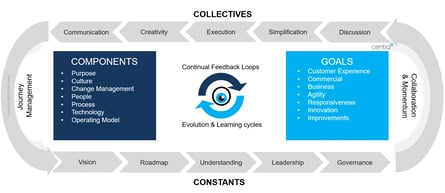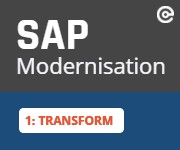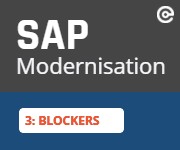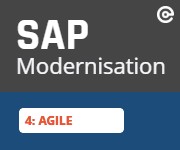Transforming your Vision
In Part 1, I introduced some of the areas where we note challenges facing SAP modernisation programmes and lessons learnt which can be embedded to reduce ‘success constraints’. In this blog, I take a more in-depth look into the first of these, Understanding and reinforcing the transformation vision. There is a lot to cover here so let’s break this down further into a focus on Understanding, Transformation and reinforcing the Vision.
Firstly, let’s define transformation to ensure there is absolute clarity, Transformation is about how you change, how and why you deliver services and customer experiences today to how you will deliver them in the future. This can be divided into smaller programmes of change such as service digitisation and modernisation. Remember modernisation is not a specific problem or a destination but rather something you are constantly working towards! I have written this blog as a series of unconnected considerations and lessons learnt from many SAP transformation programmes we have successfully delivered.
One of the techniques we find most effective in removing success constraints is problem visualisation. I really struggled with maths at school, but it was a fantastic maths teacher who first introduced me to how we can visualise problems to help capture the key components of the problem and the relationships between them. With transformation projects, the key is creating the physical representation of the visualisation as a team, as this jointly sparks ideas and prioritisation dialogue as well as collectively discussing and sharing understanding to create the agreed visualisation.
Problem visualisation:
Most transformations are complex, so it helps to have a structure to your approach in problem visualisation. I often use and refine the following simple diagram to structure the components and collective discussions. Companies must continually adapt and adopt through transformation in response to dynamic and changing macroeconomic conditions, competitive threats, innovation and above all customer needs. Transformation Goals must be focused on increased value creation by changing the why, the way, the what and the how we do things, to respond faster and more consistently to changing business needs. This invariably involves refining Goals and purpose, which is connected to the “what”, in the why you do what you do.
Understanding Modernisation:
Modernisation is not one problem, but a vision made up of multiple linked problems across a business. Visioning and setting Goals is the first step once these problems are understood, but regularly revisiting these as you build the modernisation roadmap is imperative. Things will change, so stay open-minded, do not be so rigid, recognising and incorporating these as learning is a key to removing success constraints.
To achieve change, the input of this typically involves organisational leaders offering constant clarity in vision and purpose to continually re-affirm what should be done differently and why. Maintaining good clear communication and understanding with governance at all levels of the business is both the most critical and hardest aspect of any programme of change. It is a constant through the programme, regardless of duration and learnings applied.

Mindset Change: It is OK to challenge Culture and Purpose as Components when they may be regarded as Constants and/or Collectives. The reason we include them as components is they often need to change throughout a transformation, particularly in terms of mindsets. It is crucial that they are challenged as they are a common success constraint, something I will discuss in later blogs, appearing as resistance to change and failure to adopt a new mindset. There will be limited benefit to transforming SAP to Azure if you still intend or manage it with the previous Operating Model, Goals, processes or mindset.
Remove the FUD: Just like so many businesses managing the challenges of Coronavirus, when faced with the fundamental need to transform at speed, i.e. survive, it is possible to transform more quickly because the survival instinct frees you to think, adapt and adopt differently. Most transformations represent evolution, survival and growth only without the survival instinct is so prevalent, although uncertainty and doubt may be. Doubters are invariably those not involved from the off-set, but become involved over time or do not fully understand the transformation goals or vision.
Embrace: Doubts often originate from mindsets which may not be ready or open to embracing, adapting and adopting in the same way.
Constants in visualisation help support collaboration and maintain momentum, whilst Components will change and must be allowed to change through transformation. Hence Culture and Purpose are denoted as Components, to ensure these evolve and align to the changing business needs.
For those with a more logical perspective, when sharing the transformation vision, there simply may not be data points or the metrics to enable all the problems to be defined. Again, this is normal and it is where we leverage Collaboration to think around the problem areas and define the goals. Problem solving and visualisation are elements of transformation, but proportional to creating customer understanding. It’s also important to champion creativity, innovation and continual improvement as contributors to a better customer experience.
Feedback Loops: At the core of the visualisation are continual feedback loops, evolution and learning cycles. These support transformation success between the components and the goals through the support of the Constants and Collectives to Collaborate, to maintain momentum even when it gets tough and to manage out problems that emerge throughout the journey. Be sure it will get tough, and the vision may become blurred. Expect this, embrace this, and always keep perspective but holding belief in the shared vision and Constants will ensure you embed learning and feedback to maintain momentum.
Refine and Reinforce: Which leads us to the final element of reinforcing the transformation vision. It should be no mystery that the most successful transformations have the strongest company-wide leadership who continually work together to maintain momentum, overcome the challenges and continually reinforce the transformation vision. Increasingly, transformations are shaped and evolve through more detailed data analysis, machine learning and artificial intelligence but it is the continual reinforcement of the goals and vision whilst embedding feedback which reduces success constraints.
Incorporate Lessons Learnt: Learning lessons from previous programmes of change and where success constraints appeared often points to a lack of clarity or shared “Understanding” of the vision and how to achieve the Goals. Invariably multiple linked problems can present a very big challenge in “understanding” how problems interact with one another and how to achieve overall success. Visualising the problems with the Customer Journey enables transformation teams to provide a clear vision and goals with a supporting roadmap to provide this improvement in understanding and continually reinforce it.
It is important to remember, transformation Goals are not any one destination but something that constantly evolves. The modernisation roadmap provides a simple visualisation of the problems, how the Constants, Collectives and Components connect through Collaboration to the Goals.
Keep the Faith: As a change leader, keep the faith and focus on the agreed goals, ensuring all parties continually understand their contribution and actions within the journey, whilst maintaining an environment that allows everyone to interact and collaborate. But you have to reinforce the vision, as this will become easily clouded by the inevitable challenges and issues a transformation project will encounter. Keep faith in your team, your vision and your goals and above all those around you to realise the transformation.
In the next blog, I take a more depth look at managing out decision-making blockers. Whilst data points and feedback are essential, they can also work against agile decision making and maintaining momentum if not managed effectively.
Discover how we have helped customers with their SAP Modernisation
Read more:




